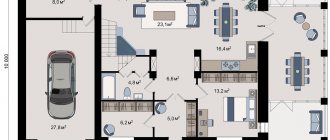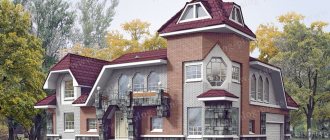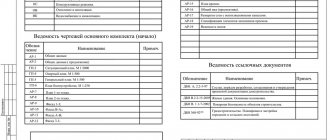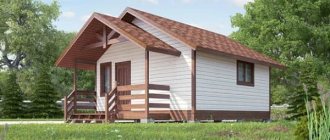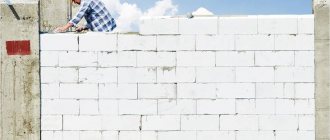Design features of the series and facade finishing
The external panels of the building are made of three-layer expanded clay concrete 32 cm thick; The walls inside the house, which are load-bearing, are reinforced concrete panels with a thickness of 16 cm, and the interior partitions are made of gypsum concrete and have a thickness of 80 mm. Floor ceilings are made of reinforced concrete panels 14 cm thick. The entire area under the building is occupied by a spacious technical basement, where engineering networks and communications are located.
Houses of series II-57 are lined with tiles (small-sized, glazed or ceramic)
yellow, blue, pink or light green. Heating, hot and cold water supply - central city networks. The disadvantages of the series are considered to be poor sound insulation of inter-apartment walls and insufficient ventilation.
Project 57 destroyers
Destroyers of the “Gnevny” (project 57 bis) – 8+1 units
Laid down as destroyers, May 19, 1966. reclassified into DBK, and after modernization - into BPK. The need for expensive modernization was caused by the low efficiency of the KSShch anti-ship missile system.
WRATHY (serial number 1401). 11/16/1957 laid down at the plant named after 61 Communards in Nikolaev and on December 17, 1957, was included in the lists of Navy ships, launched on November 30, 1958, entered service on January 10, 1960 and included in the Black Sea Fleet on August 22, 1960, 21 – 26.1. 1967 and 9-15.1.1969 paid visits to Massawa (Ethiopia), 15 – 20.10. 1968 and 20 - 25.4.1972 - to Casablanca (Morocco), 2-7. 1.1969 - to Aden (South Yemen), 5 - 9.4.1969 - to Nairobi (Mauritius), 22 - 27.11.1975 - to Bombay (India) and 25-30.8.1976 - to Vancouver ( Canada). 1 – 31.6.1967 and 1.4 – 31.12.1968, being in the war zone, carried out a combat mission to assist the armed forces of Egypt, and 5 – 30.6.1967 - the armed forces of Syria. On March 13, 1969, it was transferred to the KTOF. In the period from 1972 to December 30, 1973, it was modernized, rebuilt in Nikolaev according to project 57-A and on March 7, 1974 it was reclassified as a BOD. On April 8, 1988, it was disarmed, expelled from the Navy in connection with its transfer to the OFI for dismantling and sale, and disbanded on July 17, 1988.
GREMYASCHY , from 25.8.1988 G.-OS-315 (serial number 771). 12/17/1957 enrolled in the lists of Navy ships and laid down on February 25, 1958 at the A.A. Zhdanov shipyard (Northern Shipyard) in Leningrad, launched on April 30, 1959, and entered service on June 30, 1960. and on December 19, 1960 it was included in the Northern Fleet. In the period from 1966 to January 29, 1968, it was modernized, rebuilt in Leningrad according to project 57-A and on January 20, 1969, reclassified into the military-industrial complex. 14 – 27.5.1970 paid visits to Havana and Cienfuegos (Cuba), 10–15.9.1971 – to Oslo (Norway) and 21–26.9.1971 – to Rotterdam (Holland). In 1971, while in a war zone, he carried out a combat mission to assist the Egyptian armed forces. 1 On July 7, 1987, it was withdrawn from combat service, disarmed and reclassified into the OS, and on October 2, 1991, it was excluded from the lists of Navy vessels in connection with its transfer to the OFI for dismantling and sale, and in 1994 it was sold to a private company in India for dismantling metal. During his service, he wore the Guards Naval Flag, inherited from the Project 7 EM of the same name.
UPORNY , from January 27, 1992-PKZ-12 (serial number 1402). On April 9, 1958, it was laid down at the plant named after 61 Communards in Nikolaev, launched on October 14, 1959, entered into service on December 3, 1960, and on 20. T2.1960 it was included in the Pacific Fleet. In the period from December 26, 1967 On March 22, 1968, it underwent a major overhaul at Dalzavod in Vladivostok, and in the period from February 7, 1977 to February 3, 1978, it was modernized, rebuilt there according to project 57-A, and on August 3, 1977 it was reclassified into the military-industrial complex . In 1969, while serving in the Indian Ocean, he made business visits to Zanzibar (Tanzania), Male (Maldives), Umm Qasr (Iraq), Bandar Abbas (Iran) and Berbera (Somalia). On June 24, 1991, it was withdrawn from service, disarmed and reorganized into the PKZ, and on June 29, 1993, it was excluded from the lists of Navy vessels in connection with its transfer to the OFI for dismantling and sale.
BURNING (serial number 772). On April 9, 1958, she was added to the list of Navy ships and on June 23, 1958, she was laid down at the A.A. Zhdanov shipyard (Northern Shipyard) in Leningrad, launched on October 14, 1959, and entered service on December 23, 1960. and on January 3, 1961 it was included in the Northern Fleet. In the period from 6.2.1967 to 10.1.1969 it was modernized, rebuilt in Leningrad according to project 57-A and on 10.21.1969 reclassified to BOD. 1.1 – 12/31/1970, being in a war zone, carried out a combat mission to assist the armed forces of Egypt. 10 - 15.9.1971 and 10 - 15.10.1977 visits to Oslo (Norway), 21-26.9.1971 - to Rotterdam (Holland), 12-17.5.1975 - to Boston (USA) and 24 -29.5.1977 – to Cherbourg (France). On July 30, 1987, it was disarmed and expelled from the Navy in connection with its transfer to the OFI for dismantling and sale; on August 6, 1987, it was disbanded and subsequently sold to a private company in Spain for cutting into metal.
PROUD (serial number 90). On December 17, 1967, she was included in the list of Navy ships and in May 1959 was laid down at the Lenin Komsomol plant in Komsomolsk-on-Amur, launched on May 24, 1960, and entered service on February 6, 1961 and November 15, 1961. included in the Pacific Fleet. 28-31.3.1968 paid a visit to Madras and 3 - 6.4.1968 - to Bombay (India). In 1973 – 1975 modernized, rebuilt at Dalzavod in Vladivostok according to project 57-A and reclassified into BOD on June 20, 1975, and disarmed on July 30, 1987 and expelled from the Navy in connection with transfer to OFI for dismantling and sale, August 9, 1987 g. was disbanded and subsequently sunk in the Bering Sea off the coast of Kamchatka as a target while ensuring practical missile firing.
BOYKY (serial number 1403). On April 2, 1959, it was laid down at the plant named after 61 Communards in Nikolaev and on July 8, 1959, it was included in the list of Navy ships, launched on December 15, 1959, entered service on June 26, 1961, and on October 14, 1961, it was included in the Black Sea Fleet. . In the period from October 23, 1970 to April 6, 1973, it was modernized, rebuilt in Nikolaev according to the 57-Ai project, and reclassified as a BOD on November 2, 1972. On June 8, 1970, it was transferred to the KSF. 6 – 11.8.1966 paid a visit to Alexandria (Egypt), 15-20.2.1969 – to Conakry (Guinea), 5-10.3.1969 – to Lagos (Nigeria), 12 – 17.11.1974 - in Oslo (Norway) and 12 - 17.5.1975 - in Boston (USA). 9.2.1988 disarmed, expelled from the Navy in connection with transfer to OFI for dismantling and sale and 17.7.1988 disbanded, and in 1989 sold to a private company in Spain for scrapping, but during towing from the Kola Bay to El- Ferolo was caught in a strong storm and washed up on coastal rocks off the coast of Northern Norway.
ZORKY (serial number 773). 9.4.1958 was included in the list of ships of the Navy and 1 7.4.1959 was laid down at the plant named after A.A. Zhdanov (Northern Shipyard) in Leningrad, launched 30.4.1960, entered service 30.9.1961 and 14.10 .1961 included in the KBF. In the period from May 29, 1969 to December 31, 1971, it was modernized, rebuilt in Leningrad according to the 57-Ai project, and reclassified as a BOD on October 27, 1971. In the period from February 10, 1984 to February 27, 1987, a major overhaul took place in Murmansk. 12 – 1 7.11.1974 paid a visit to Oslo (Norway) and 12 - 17.4.1979 - to Bissau (Guinea-Bissau). On June 1, 1992, reclassified to the TFR, on June 30, 1993, disarmed, expelled from the Navy due to transfer to the OFI for dismantling and sale, and disbanded on December 31, 1993.
DARLING (serial number 774). On April 9, 1958, she was included in the list of Navy ships and on October 10, 1959, she was laid down at the A.A. Zhdanov plant (Northern Shipyard) in Leningrad, launched on February 4, 1960, and entered service on December 30, 1961 and 12.1. 1962 included in the Northern Fleet. In the period from November 20, 1967 to April 22, 1972, it was modernized, rebuilt in Leningrad according to project 57-A, and on October 20, 1970 it was reclassified as a BOD. 4 – 9.8.1973 paid a visit to Havana (Cuba). On August 7, 1977, it was withdrawn from service, mothballed and laid up in the Kola Bay, on April 19, 1990 it was disarmed and expelled from the Navy in connection with its transfer to the OFI for dismantling and sale, and on October 1, 1990 it was disbanded and converted in the SM to ensure the execution of combat exercises.
BRAVE , from January 25, 1969 - ENS-73 (serial number 91). 9.4.1959 was included in the list of ships of the Navy and in 1959 was laid down at the Lenin Komsomol plant in Komsomolsk-on-Amur, launched in 1961, but 1.7.1963 was removed from construction and mothballed, 25.1.1969 . was reorganized into an energy vessel, and on March 11, 1982, it was excluded from the lists of Navy ships in connection with the transfer to Glavvtorchermet for dismantling and cutting into metal.
Total displacement 4192 standard 3500 t length 138.9 m beam 14.84 m draft 4.47 m PTU power 2×42500 hp travel speed: maximum 34.5 economic 18 knots. economical cruising range is 3000 miles. Armament: 2x1 PKRK SM-59 launchers (12-16 KSShch missiles), 4x4 57-mm ZIF-75 guns, 2x2 533-mm TA, 2 RBU-2500 (128 RGB-25), 1 Ka-15 helicopter. Crew 290 people, including 20 officers.
PROJECT 57-A
Total displacement 4500 standard 3500 t length 140.6 m beam 14.84 m draft 4.65 m Power 2×42500 hp speed: maximum 32 economic 18 knots Armament: 1x2 Volna air defense missile launchers (32 missiles), 2x4 57-mm ZIF-75 guns, 4x2 30-mm AK-230 guns, 2x5 TA-53-1134, 3RBU-6000, 1 Ka-25 helicopter Crew of 297 people, including 20 officers.
Features of apartment layouts
The standard layout of a 3-room apartment has built-in wardrobes and mezzanines. In addition, the advantages of standard houses of the II-57 series include isolated rooms and separate bathrooms. But the kitchens in the houses of the series remain small. A positive aspect of the II-57 series was the reduction in the number of load-bearing walls - there were significantly more options for redevelopment.
Self-propelled gun from aircraft manufacturers. Project ASU-57 OKB-115
In the second half of the forties, the development of new types of military equipment intended for airborne troops began. Among other things, the Airborne Forces needed light airborne artillery self-propelled guns. In the shortest possible time, several similar vehicles with different weapons were proposed. One of the most interesting designs was the ASU-57 machine, developed at OKB-115.
Glider and self-propelled gun
In the creation of new armored vehicles for the Airborne Forces, the leading role was played by enterprises that had the necessary experience in this area. However, in 1948, OKB-115, headed by A.S., decided to try its hand at building self-propelled guns. Yakovlev. At that time, the bureau was developing the Yak-14 landing glider, and in parallel it was planned to create a light self-propelled gun compatible with it. The new model was called ASU-57 (“Airborne self-propelled unit, 57 mm”), due to which it can be confused with the development of the same name from Plant No. 40.
ASU-57 OKB-115 being tested
According to some sources, the ASU-57 self-propelled gun project was created not by OKB-115, but by the Kharkov tank repair plant No. 115. However, data discovered and published in recent years refute this version. The new model of ground equipment was made by the aviation design bureau.
Despite the lack of experience, OKB-115 quickly coped with the new task. The design task for the self-propelled guns appeared in early February 1948, and by the end of February the set of drawings was supposed to go into production. The start of factory testing was scheduled for the end of March. During development, it was necessary to adjust the approved appearance of the vehicle, but radical changes were not envisaged.
Design Features
The ASU-57 project provided for the construction of a tracked self-propelled gun of a logging layout with a partially open fighting compartment.
The front part of the hull was given over to weapons and crew seats, and behind them was the engine compartment. Measures were taken to simplify operation in the Airborne Forces, in particular landing. The self-propelled gun received a welded hull with differentiated armor with a thickness of 4 to 12 mm. The frontal projection was covered with a large inclined sheet, above which the so-called lantern - a curved shield with viewing devices. For suspension under the cargo glider, the canopy was folded backwards and downwards. The front plate had a niche for a gun mount.
Side view. A distinctive low silhouette is noticeable
A GAZ-M-20 gasoline engine with a power of 50 hp was mounted in the rear of the hull on the right along the side. The transmission included a bevel main gear, a four-speed GAZ-AA gearbox, two final clutches and two single-row final drives. The engine and transmission were controlled by a traditional set of levers and pedals. The vehicle's electrical system was based on the GBF-4105 generator.
The chassis had four rubberized road wheels with torsion bar suspension on each side. The same roller without a tire was used as a guide wheel. The drive wheels were placed at the rear. The caterpillar was assembled from tracks borrowed from the T-20 Komsomolets tractor.
A machine for mounting the main weapons was placed in the bow of the hull. The ASU-57 received a 113P automatic cannon with a caliber of 57 mm, which was originally created for promising fighter aircraft. The gun was mounted with a rearward shift, due to which only a limited part of the barrel with a muzzle brake protruded through the embrasure. The barrel passed through the habitable compartment, and the breech was located next to the engine compartment.
The 113P gun used automation based on a short recoil of the barrel. Technical rate of fire – 133 rounds per minute. Next to its breech on the left there was a feed mechanism with a box for loose tape for 15 unitary shots of 57x350 mm. Nearby there were two boxes for 16 and 20 shells. Normal ammunition was determined to be 31 shots, with overload - 51, with an additional belt placed in a separate box. Reloading after the first tape was consumed was carried out hydraulically. The next reload required crew intervention.
Gun mount with 113P cannon
The gun mount received hydraulic drives for aiming in two planes, as well as a hydraulic reloading mechanism. Horizontal guidance was carried out in a sector 16° wide, vertical – from -1° to +8°. For guidance, an aviation collimator sight PBP-1A was used. Later it was replaced by the K8-T product, borrowed from tank machine gun installations.
The crew consisted of only two people. To the right of the gun in the nose of the hull was the driver. The commander-gunner was placed on the left. For observation, they had their own viewing devices in the lantern. Access to the crew seats was through the roof. Standardly, the self-propelled guns were supposed to have a radio station, but it was not installed on the experimental vehicle.
The length of the ASU-57 from OKB-115, taking into account the gun, slightly exceeded 4.5 m. The width was 3.8 m, the height was only 1.38 m in the firing position or just over 1 m with the canopy folded. Combat weight - 3255 kg. The car was supposed to reach speeds of up to 45 km/h, and the 120-liter tank gave a cruising range of 167 km. ASU-57 had to overcome various obstacles, incl. fords.
Failed tests
At the beginning of the summer of 1948, Plant No. 115 transferred a prototype of the new amphibious self-propelled gun to the Kubinka training ground for testing by the army. For several weeks the vehicle demonstrated performance and fire performance. The test results were far from desired.
View from the engine compartment to the fighting compartment and crew seats
The power plant of the self-propelled guns turned out to be weak. Service was difficult. There was no electrical wiring shielding. After 62 hours of operation, the engine had to be replaced due to serious damage. The transmission, however, worked normally and without significant problems. The chassis was not strong enough, and therefore it was necessary to regularly tighten the bolts and nuts. There were no slats above the caterpillar, which caused the self-propelled gun to become covered in dust. The absence of a muffler on the exhaust pipe created discomfort and led to a fire risk.
Firing tests were limited to 21 shots, after which all the shortcomings became clear. The muzzle brake of the 113P gun raised dust, interfering with observation, and also had a negative impact on the crew. In addition, with the first shot, he broke the only headlight. The hydraulic guidance system provided insufficient angles of movement of the gun. At the same time, there was no synchronized movement of the gun and sight. During operation, the pressure in the hydraulic system quickly dropped, interfering with guidance. The design of the guidance systems excluded the use of a traveling gun stopper.
The collimator aircraft sight made aiming at long distances difficult. The ammunition supply system turned out to be unsuccessful. The project provided for a quick replacement of the belt by the gunner, but in practice, reloading required the work of two gunners and took about 10-15 minutes. In this case, people had to leave the protected compartment.
There were also many other shortcomings. Poor protection of the crew from shelling from the side and stern, lack of entrenching tools, insufficient spare parts and accessories, etc. were noted.
Modified version of ASU-57
Based on the test results, the ASU-57 was considered unsuccessful and did not meet the army’s requirements. The prototype was returned to the manufacturer. Soon comparative tests of several new models were completed, and the machine of the same name from plant No. 40 was adopted.
Attempt at modernization
In the same 1948, OKB-115 made an attempt to correct the shortcomings and improve the existing self-propelled guns.
New proposals were implemented on a prototype, and then in the form of a full-fledged prototype. The modernization project included the abandonment of the semi-open habitable compartment. Behind the lantern additional armor appeared, forming the roof of the cabin. The viewing devices in the lantern were redone. Boxes for spare parts and other equipment, as well as external fastenings, have undergone a major update. The composition of the power plant was preserved, but all the auxiliary units that caused complaints during testing were redone.
The gun mount lost its hydraulics and was controlled by manual mechanisms. The declination angle was brought to -2° with the possibility of increasing to -5° by opening the hatches above the breech. The hydraulics in the gun reloading mechanism were replaced with pneumatics. The PBP-1A sight was replaced by the OP-1 product with magnification. Other minor improvements were introduced.
Self-propelled gun with missile launcher
The ASU-57 still did not have machine gun armament, but now it was proposed to supplement the cannon with missiles. At the stern it was planned to mount a lightweight removable launcher for 30 RS-82 missiles. The launch was controlled from under the armor or from a remote control.
The updated ASU-57 retained the same dimensions, but became heavier to 3.33 tons. The launcher for the RS-82 added 320 kg of weight. Mobility remained at the same level.
At the end of October 1948, the ASU-57 of the second version was sent to Kubinka for new tests. After inspections, in early February 1949 it was returned to plant No. 115 without any particular complaints regarding the operation and reliability of the units. However, the military no longer considered the OKB-115 project in the context of future rearmament.
The further fate of the experimental ASU-57 is not known with certainty. Apparently, they did not save it and dismantled it for parts. The first and last project of the aviation OKB-115 in the field of ground armored vehicles did not produce the desired results. It should be noted that the bureau still made a significant contribution to the development of the airborne troops. His Yak-14 airframe entered service and was actively used for many years. However, he had to transport ASU-57 self-propelled guns developed by another bureau.


